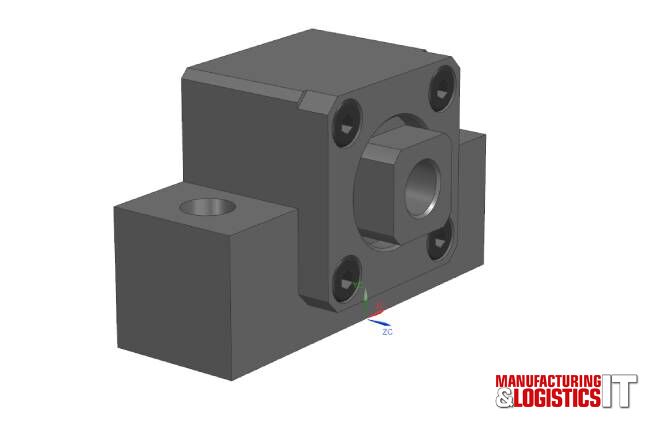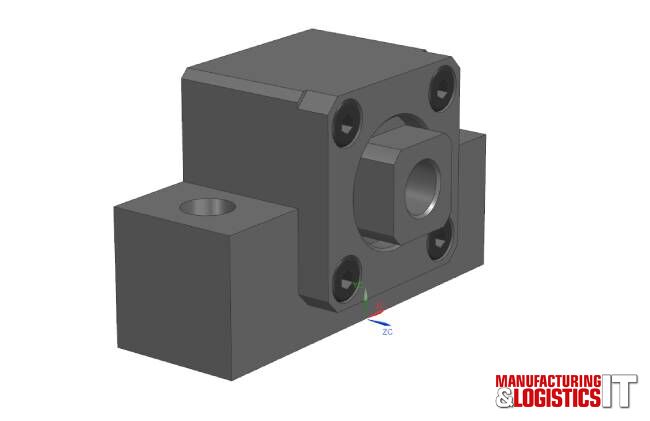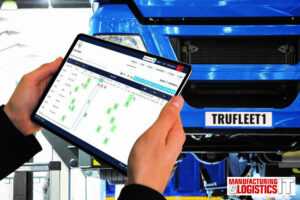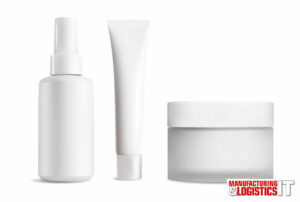Digital twin technology represents a quicker and more cost-effective route to market for new products. It is one of the fastest growing segments in engineering, with analysts McKinsey & Co forecasting that the global market for digital twin tech will grow by about 60 percent annually, reaching USD 73.5 billion by 2027.
Why are these numbers important? What they represent is the stark reality that your competitors are probably using digital twin technology already or are about to invest in it. Companies who want to remain competitive need to adopt this technology now, or risk getting left behind.

What is a digital twin and how does it impact product development?
A digital twin is a virtual replica of a current or future product, designed to simulate all the characteristics of their physical counterparts. Fundamentally, digital twin technology is the future of manufacturing and construction. It supports product development teams working on anything from a power tool to a power plant.
The ability to interact with the digitalised version enables more freedom to experiment, while also making development quicker, safer and more cost-effective than building physical prototypes. In this way, digital twins provide an almost risk-free product development environment, enabling design and engineering teams to explore more options and be more creative. The capability to use a digital twin as a testing ground without the need for physical resources ensures that product development is more efficient – and critically that it does not impact shop floor productivity.
Speed to market can also be critical to success, and a digital twin is the best way to accelerate new product development without cutting corners.
What other benefits can a digital twin bring?
Other advances in digitalisation are also helping to create feedback loops for continuous improvement of products. The Internet of Things (IoT) makes these advances more accessible as sensors can deliver data on real-world operational performance.
An example is proactive service and maintenance, as this information helps us shift from visual inspection of equipment and machinery to digital, data-driven diagnostics. In this way, predictive maintenance ensures that issues can be detected before they result in costly downtime. Communicating this data back to the product development teams can also lead to quicker fixes – simply tweak the product in the digital twin and assess how the changes work before implementing them on the assembly lines.
Furthermore, with skilled labour still at a premium, digital twin technology can help with workforce training to ensure higher competency levels. Whenever your business introduces new components, products or processes, this means more training for the workforce. Traditionally CAD data, technical drawings and product specification sheets have helped companies to ensure that all elements of the workforce from engineering to the shop floor are aligned and informed. Digital twins take this several steps further, providing a visual guide that is easier to understand.
The importance of standardisation
Within this context of higher creativity, it is important to remain grounded. Using standard components is a proven method of optimising production efficiencies, so why change this when working with a digital twin? Through greater integration between standard components and digital processes, manufacturers can realise tangible improvements ranging from improved output quality to reduced downtime.
Using standard components in your digital twins helps you develop machines more quickly and accurately, reducing the cost, risk and complexity for manufacturers of implementing new solutions. In short, it optimises your product development processes from the very beginning.
Developing a digital supply chain
It is therefore vital that you develop a digital supply chain by finding partners who can provide digital versions of their standard components. Look for a provider with an established range of standard components that already have digital profiles you can easily integrate into your digital twins. For example, at norelem we have integrated a product selection tool in our online shop which allows engineers to specify the components they require including material, dimensions, shapes and additional feature requirements. The website will then suggest the ideal components for each aspect of a project. In addition, the website enables engineers to access and easily download 2d and 3d CAD drawings of our components, which are compatible with most design platforms including Catia, Creo, Inventor, NX, SolidEdge and SolidWorks.
Understanding how a component works is also vital to deploying it correctly in a digital twin. If you are looking at using new components or simply want a refresher on what a part actually does, ask your supplier. Support at this level can vary wildly, but a good partner will have resources that are available for free. The norelem ACADEMY training centre is an online knowledge database containing example applications as well as best practice videos. You can even drill down further with detailed technical data on the most important properties and functions of each component.
If you prefer face-to-face training, the norelem ACADEMY can come to you! The norelem SHOWTRUCK will drive to your facilities and deliver free training.
Digital expertise
Manufacturing and engineering are exciting, dynamic sectors. In an increasingly competitive global marketplace, digital twin tech can help you improve productivity. However, ensuring you have the right partner with a comprehensive range of standard components – in the digital and real worlds – can make all the difference.
- SEO Powered Content & PR Distribution. Get Amplified Today.
- PlatoData.Network Vertical Generative Ai. Empower Yourself. Access Here.
- PlatoAiStream. Web3 Intelligence. Knowledge Amplified. Access Here.
- PlatoESG. Carbon, CleanTech, Energy, Environment, Solar, Waste Management. Access Here.
- PlatoHealth. Biotech and Clinical Trials Intelligence. Access Here.
- Source: https://www.logisticsit.com/articles/2023/12/19/what-is-a-digital-twin-and-why-does-it-matter
- :is
- :not
- 2D
- 3d
- 60
- 73
- a
- ability
- About
- Academy
- accelerate
- access
- accessible
- accurately
- actually
- addition
- Additional
- adopt
- advances
- aligned
- All
- allows
- almost
- already
- also
- an
- Analysts
- and
- Annually
- anything
- applications
- ARE
- AS
- ask
- aspect
- Assembly
- assess
- At
- available
- back
- BE
- before
- Beginning
- behind
- benefits
- BEST
- between
- Billion
- bring
- Building
- business
- but
- by
- CAD
- CAN
- capability
- centre
- chain
- change
- Changes
- characteristics
- CO
- come
- communicating
- Companies
- compatible
- competitive
- competitors
- complexity
- component
- components
- comprehensive
- construction
- context
- continuous
- corners
- correctly
- Cost
- cost-effective
- costly
- counterparts
- create
- Creative
- creativity
- critical
- Current
- cutting
- data
- data-driven
- Database
- deliver
- deploying
- Design
- designed
- detailed
- detected
- develop
- Development
- development teams
- diagnostics
- difference
- digital
- digital twin
- Digital twins
- digitalisation
- Digitalised
- dimensions
- does
- down
- download
- downtime
- Drawings
- drive
- dynamic
- each
- easier
- easily
- efficiencies
- efficient
- elements
- enables
- enabling
- Engineering
- Engineers
- ensure
- ensures
- ensuring
- Environment
- equipment
- established
- Ether (ETH)
- Even
- example
- exciting
- experiment
- explore
- facilities
- fastest
- fastest growing
- Feature
- feedback
- finding
- fixes
- Floor
- For
- Free
- Freedom
- from
- functions
- fundamentally
- further
- future
- getting
- Global
- global market
- good
- greater
- Ground
- Grow
- Growing
- guide
- Have
- help
- helped
- helping
- helps
- higher
- How
- However
- HTTPS
- ideal
- if
- Impact
- implementing
- importance
- important
- improve
- improved
- improvement
- improvements
- in
- Including
- increasingly
- information
- informed
- integrate
- integrated
- integration
- interact
- Internet
- internet of things
- into
- Introduces
- Invest
- iot
- issues
- IT
- jpg
- knowledge
- Labour
- lead
- left
- Level
- levels
- lines
- Look
- looking
- machinery
- Machines
- maintenance
- make
- MAKES
- Making
- Manufacturers
- manufacturing
- Market
- marketplace
- material
- Matter
- McKinsey
- means
- method
- more
- more efficient
- most
- Need
- New
- new product
- new products
- new solutions
- now
- numbers
- of
- on
- ONE
- online
- operational
- optimising
- Options
- or
- Other
- our
- output
- part
- partner
- partners
- percent
- performance
- physical
- physical counterparts
- plant
- Platforms
- plato
- Plato Data Intelligence
- PlatoData
- power
- practice
- predictive
- prefer
- Premium
- Proactive
- probably
- processes
- Product
- product development
- Production
- productivity
- Products
- Profiles
- project
- properties
- prototypes
- proven
- provide
- provider
- providing
- quality
- quicker
- quickly
- range
- ranging
- reaching
- real
- real world
- Reality
- Reduced
- reducing
- remain
- replica
- represent
- represents
- require
- Requirements
- Resources
- result
- right
- Risk
- Route
- safer
- Sectors
- segments
- selection
- sensors
- service
- several
- shapes
- shift
- Shop
- Short
- simply
- skilled
- So
- Solutions
- specification
- standard
- stark
- Steps
- Still
- success
- suggest
- supplier
- supply
- supply chain
- support
- Supports
- Take
- tangible
- teams
- tech
- Technical
- Technology
- Testing
- than
- that
- The
- The Future
- their
- Them
- then
- therefore
- These
- they
- things
- this
- Through
- to
- tool
- traditionally
- Training
- tweak
- twin
- Twins
- understand
- us
- USD
- use
- using
- version
- very
- Videos
- Virtual
- visual
- vital
- want
- Way..
- we
- Website
- WELL
- What
- What is
- when
- whenever
- which
- while
- WHO
- why
- will
- with
- without
- Work
- Workforce
- working
- works
- world’s
- you
- Your
- zephyrnet













